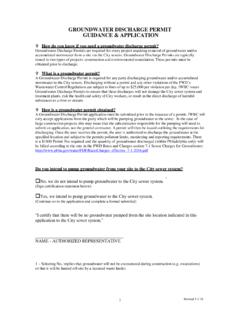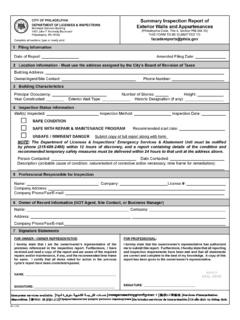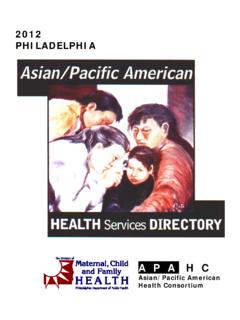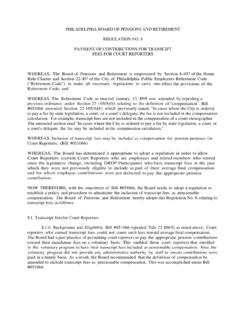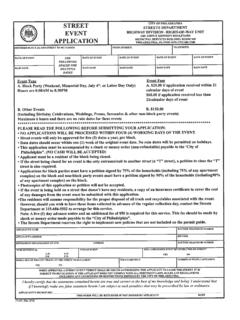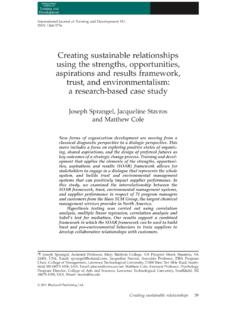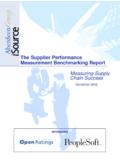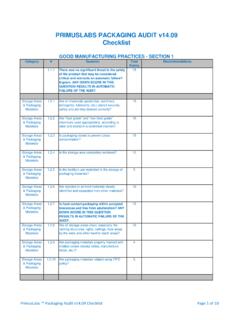Transcription of CROSS CONNECTION CONTROL MANUAL - phila.gov
1 CROSS CONNECTION CONTROL MANUAL WATER DEPARTMENT STANDARD SPECIFICATIONS for PREVENTION OF WATER CONTAMINATION CITY OF PHILADELPHIA WATER DEPARTMENT CROSS - CONNECTION CONTROL MANUAL CROSS CONNECTION CONTROL Guidelines- Issued 1978 CROSS CONNECTION CONTROL MANUAL , 1st Edition - Issued 1988 CROSS CONNECTION CONTROL MANUAL , 2nd Edition- Issued 1992 CROSS CONNECTION CONTROL MANUAL , 3rd Edition - Issued 1994 CROSS CONNECTION CONTROL MANUAL , 4th Edition - Issued 1998 CROSS CONNECTION CONTROL MANUAL , 5th Edition - Issued 2004 CROSS CONNECTION CONTROL MANUAL , 6th Edition - Issued 2006 DIRECTORY WATER DEPARTMENT CROSS - CONNECTION CONTROL requirements on Containment: Attn: CROSS - CONNECTION CONTROL Section Bureau of Laboratory Services 1500 E. Hunting Park Avenue Philadelphia, PA 19124-4941 (215) 685-1419, 1420 and 1407 Fax.
2 (215) 743-5594 Water Main Records Meter Shop ARA Tower, 2nd Floor 29th & Cambria Streets 1101 Market Street Philadelphia, PA 19132 Philadelphia, PA 19107 (215) 685-9619 or 685-6300 (215) 685-6276 or 685-6300 Fax: (215) 685-9649 Fax: (215) 685-6312 LICENSES & INSPECTIONS Permits for domestic services & fire connections: Regarding Domestic Systems: Regarding Fire Protection Systems.
3 Plumbing Unit Engineering Services Municipal Services Building Municipal Services Building 1401 JFK Blvd 1401 JFK Blvd Philadelphia, PA 19102 Philadelphia, PA 19102 (215) 686-2450, 2451 (215) 686-2470 and 2472 Fax: (215) 686-1407 Fax: (215) 686-2598 DEPARTMENT OF PUBLIC HEALTH CROSS - CONNECTION CONTROL requirements on Elimination: Environmental Health Services 321 University Avenue Philadelphia, PA 19104 (215) 685-7343, 7344, 7488 Fax.
4 (215) 382-1210 TABLE OF CONTENTS CHAPTER TITLE PAGE GLOSSARY Definitions for Commonly used CROSS Connections Terms 1 INTRODUCTION 4 Purpose of MANUAL 4 CROSS CONNECTION CONTROL in the City of Philadelphia 4 POLICY 5 AUTHORITY 6 The Commonwealth of Pennsylvania 6 The Philadelphia Water Department 6
5 CONTAINMENT REQUIREMENTS 8 Backflow Protection at the Service CONNECTION for 8 Containment Listing of Facilities in which Backflow Protection is 9 Required at the Domestic Service Backflow Protection for Fire Protection Systems 12 APPROVED BACKFLOW PREVENTION ASSEMBLIES 13 AIR GAP SEPARATION USING RECEIVING TANKS 14 INSTALLATION REQUIREMENTS 15 Mechanical Backflow Prevention Assemblies 15 TESTING AND MAINTENANCE 18 Backflow Prevention Assembly Testing 18 City Certified Backflow Technicians Responsibilities 18 Backflow Prevention Assembly Testing Procedures 20 APPENDIX 23 1 GLOSSARY DEFINITIONS FOR COMMONLY USED CROSS CONNECTION TERMS Air-Gap Separation Unobstructed physical separations between the free-flowing discharge end of a potable supply pipeline and an open or non-pressurized receiving vessel.
6 The distance between the bottom of the feed line and top rim of the vessel (vertically measured) shall be at least double the diameter (2xD) of the supply pipe. In no case shall the air-gap be less than one (1) inch. Atmospheric Vacuum Breaker (AVB) The AVB is typically used in the supply lines to slop sinks. This assembly contains a float-check, a check seat and an air inlet port. The flow of water into the body causes the float to close the air inlet port. When the flow of water stops, the float falls and forms a check valve against backsiphonage and at the same time opens the air inlet port to allow air to enter and satisfy the vacuum. An AVB is designed to protect against backsiphonage conditions only. Therefore, an AVB shall not be used for containment backflow protection.
7 Auxiliary Water Supply (System) Any water supply that does not contain City drinking water or is deemed to be non-potable. Auxiliary systems can be divided into three categories: A water system in which City water is stored, transmitted or utilized for other than a potable purpose ( , a high pressure fire system, an industrial process, a fire sprinkler system, cooling towers or swimming pools) and is open to contamination or deterioration, thus making it non-potable. A water system in which City water is further treated with chemicals or by other means. A water system in which water is derived from natural sources such as a well, river or pond. Backflow The flow of water or other liquids, mixtures, gases, or other undesirable substances through a CROSS CONNECTION into the distribution pipes of a potable water supply from any source(s) other than its intended source.
8 Backflow usually occur under two hydraulic conditions: (1) back pressure or (2) a reduced or negative supply pressure below atmospheric pressure (backsiphonage). 2 Backpressure Elevated pressure in the downstream piping system caused by pumping, elevation head, steam pressure or air pressure that exceeds the pressure in the supply piping. Backsiphonage Is the flowing back of non-potable water from a plumbing fixture or vessel into the drinking water supply due to a negative pressure within the connected drinking water supply system. City Certified Backflow Prevention Technician A City-licensed tradesman who is certified for installation, servicing and testing of backflow prevention devices. (See section ) Containment A strategic approach of applying backflow protection on the service line to a facility, wherein contaminated water is contained within the facility and prevented from affecting other services connected to the same City water main.
9 Contamination This is an impairment of potable water by the introduction or admission of any foreign substance that degrades the water quality and has the potential to create a health hazard. 3 CROSS CONNECTION Any physical CONNECTION or arrangement of pipes that allows the conveyances between potable and non-potable or questionable water source. Water may flow from one system to the other such that the potable water may become contaminated by the questionable source. Hose connections, bypass arrangements, jumper connections, removal sections, or changeover assemblies or any other temporary or permanent connecting arrangements through which backflow may occur are considered to be CROSS connections. The direction of flow depends on the pressure differential between the two systems. Double Check Valve Assembly (DCV) One of the type of backflow prevention assemblies which is composed of two independently acting check valves along with tightly closing shutoff valves attached at each end of the device and fitted with test cocks.
10 A DCV assembly is used against backpressure and backsiphonage. In general, a double check valve assembly installation is used in minimum hazard systems. See list of Approved Double Check Valve Assemblies. Pressure Vacuum Breaker (PVB) This assembly contains an independently operating, internally loaded check valve and an independently operating, loaded air inlet valve located on the discharge side of the check valve. This assembly is equipped with test cocks and shutoff valves attached at each end of the assembly. This assembly is designed to protect against backsiphonage only. PVB assembly shall not be used for containment backflow protection. Reduced Pressure Zone Assembly (RPZ) A type of backflow prevention assembly, which contains two independently acting check valves together with a hydraulically operated, mechanically independent, pressure differential relief zone located between the check valves.
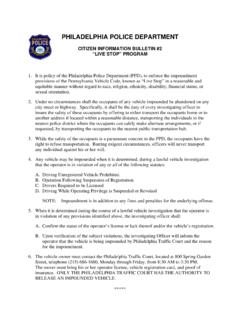
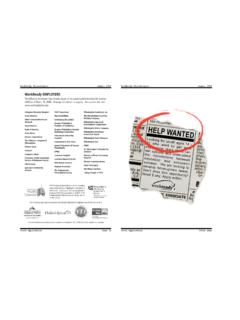
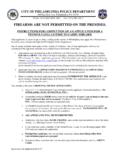
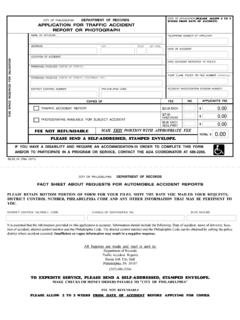
![[PSA] Philly: Classaction lawsuit brings changes in …](/cache/preview/1/4/c/8/8/d/5/c/thumb-14c88d5c5b2f1fee5e561fc7daceb397.jpg)
